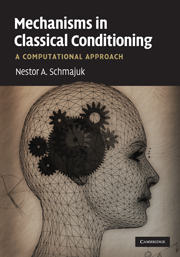Book contents
- Frontmatter
- Contents
- Preface
- Acknowledgments
- Abbreviations
- Part I Introduction
- Part II Attentional and associative mechanisms
- 2 An attentional–associative model of conditioning
- 3 Simple and compound conditioning
- 4 The neurobiology of fear conditioning
- 5 Latent inhibition
- 6 The neurobiology of latent inhibition
- 7 Creativity
- 8 Overshadowing and blocking
- 9 Extinction
- 10 The neurobiology of extinction
- Part III Configural mechanisms
- Part IV Attentional, associative, configural and timing mechanisms
- Part V Conclusion: mechanisms of classical conditioning
- References
- Author Index
- Subject Index
5 - Latent inhibition
from Part II - Attentional and associative mechanisms
Published online by Cambridge University Press: 23 May 2010
- Frontmatter
- Contents
- Preface
- Acknowledgments
- Abbreviations
- Part I Introduction
- Part II Attentional and associative mechanisms
- 2 An attentional–associative model of conditioning
- 3 Simple and compound conditioning
- 4 The neurobiology of fear conditioning
- 5 Latent inhibition
- 6 The neurobiology of latent inhibition
- 7 Creativity
- 8 Overshadowing and blocking
- 9 Extinction
- 10 The neurobiology of extinction
- Part III Configural mechanisms
- Part IV Attentional, associative, configural and timing mechanisms
- Part V Conclusion: mechanisms of classical conditioning
- References
- Author Index
- Subject Index
Summary
In this chapter, we explain how the SLG model (Schmajuk et al., 1996; Schmajuk & Larrauri, 2006; Schmajuk, 2002) introduced in Chapter 2 describes the multiple properties of latent inhibition (LI). We also discuss alternative approaches to LI.
Simulation procedures
In all the simulations presented in this chapter, different measures of conditioning were simulated as follows. When a conditioned emotional response paradigm was simulated, CR strengths were transformed into suppression ratios. Suppression ratios were calculated with the equation A/(A + B), where A represents the appetitive responding (e.g. bar pressing for food, water licking) when the CS is present, and B represents the appetitive responding during the preceding non-CS period of equal duration. We assume that responding during the CS period is given by β − CR(CS), and responding during the preceding non-CS period is given by β − CR(CX), where β is proportional to the intensity of the appetitive behavior. Therefore, the suppression ratio was calculated by (β − CR(CS))/((β − CR(CX)) + β − CR(CS)) = (β − CR(CS))/(2β − CR(CS) − CR(CX)). In order to avoid unrealistic negative suppression ratios, the value of β was arbitrarily set to the maximum value of the CR(CS). Notice that when V(CX,US) is close to or smaller than 0, then the suppression ratio is well approximated by (β − CR(CS))/(2β − CR(CS)).
- Type
- Chapter
- Information
- Mechanisms in Classical ConditioningA Computational Approach, pp. 64 - 92Publisher: Cambridge University PressPrint publication year: 2010



